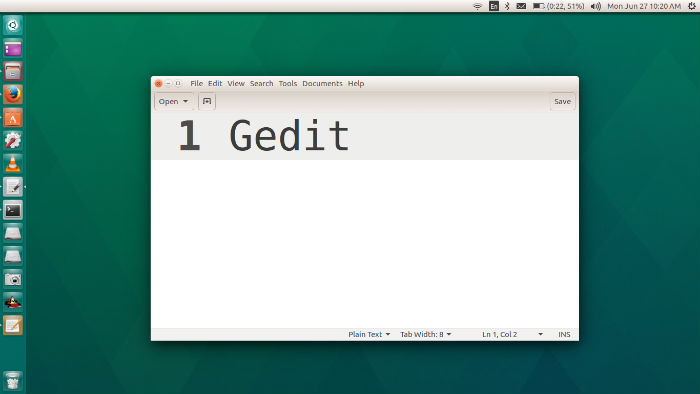Gedit 3.18 is the official text editor in Ubuntu 16.04. Here’s how to install Gedit 3.10 on Ubuntu 16.04. An easy way to get the Gedit Toolbar Back on Ubuntu 16.04 Systems.
Gedit Text Editor is the default GUI text editor in the Ubuntu operating system. It is UTF-8 compatible and supports most standard text editor features as well as many advanced features. These include multilanguage spell checking, extensive support of syntax highlighting, and a large number of official and third party plugins.

Notable Features
- Full support for internationalized text (UTF-8)
- Configurable syntax highlighting for various languages (C, C++, Java, HTML, XML, Python, Perl and many others)
- Undo/Redo
- Editing files from remote locations
- File reverting
- Print and print preview support
- Clipboard support (cut/copy/paste)
- Search and replace with support of regular expressions
- Go to specific line
- Auto indentation
- Text wrapping
- Line numbers
- Right margin
- Current line highlighting
- Bracket matching
- Backup files
- Configurable fonts and colors
- A complete online user manual
- A flexible plugin system which can be used to dynamically add new advanced features
Gedit 3.18 text editor has been released with an aim to create a modern, slicker interface which wastes less screen estate and lets you focus on the text or code you are writing. No features were harmed in the making of this new UI. These changes bring gedit in line with the latest GNOME conventions and take advantages of the new design patterns and GTK widgets.
Credit: https://blogs.gnome.org/nacho/2014/01/15/gedit-has-a-new-face/
Executed the following commands in terminal and get gedit with toolbar back. It is older version of Gedit 3.10 instead of 3.18 officially in Ubuntu 16.04, but who cares, I million times like toolbar more then a new version has to offer.
Code:
sudo apt-add-repository ppa:mc3man/older
sudo apt update
sudo apt install gedit gedit-plugins
sudo apt autoremove
apt-cache policy gedit
gedit &
Credit: http://ubuntuforums.org/showthread.php?t=2326742&page=2&p=13508865#post13508865
Command Line Tips
Opening gedit via the command line allows the user to take advantage of several options unavailable from the GUI menu. If a path is not included in the startup command, gedit will look for the file in the current directory. If the file is not found, gedit will open a blank file with the file name entered on the command line:
To open a specific file:
gedit filename
To open multiple files:
gedit file1 file2
To edit system files such as sources.list and fstab, open it with administrative privileges. Note graphical applications use gksudo rather than sudo.
gksudo gedit
To open at a specific line number, useful when an error message includes the line number, include “+”. (gksudo is used in this example since the file is a system file owned by root):
gksudo gedit +21 /etc/apt/sources.list
